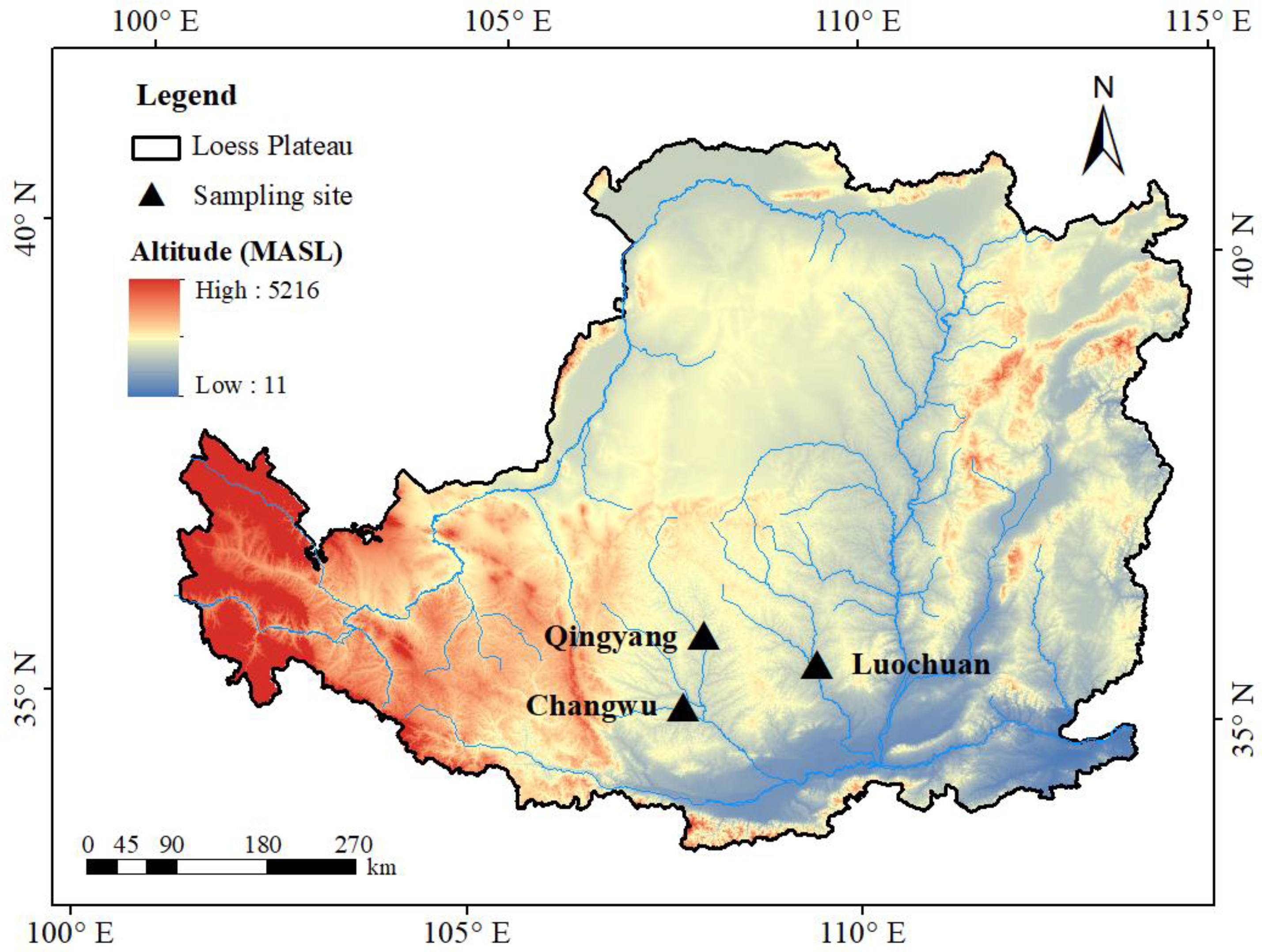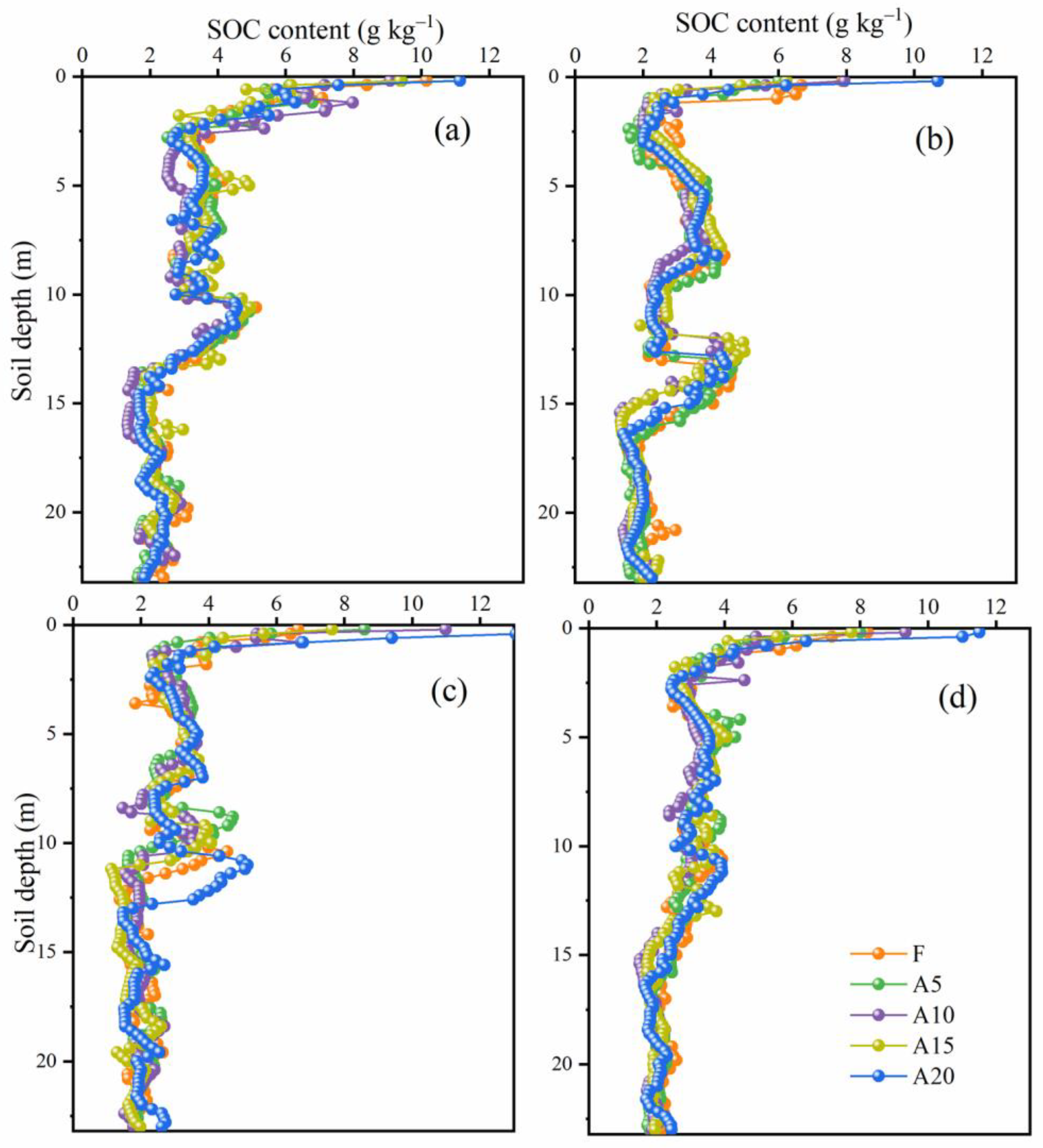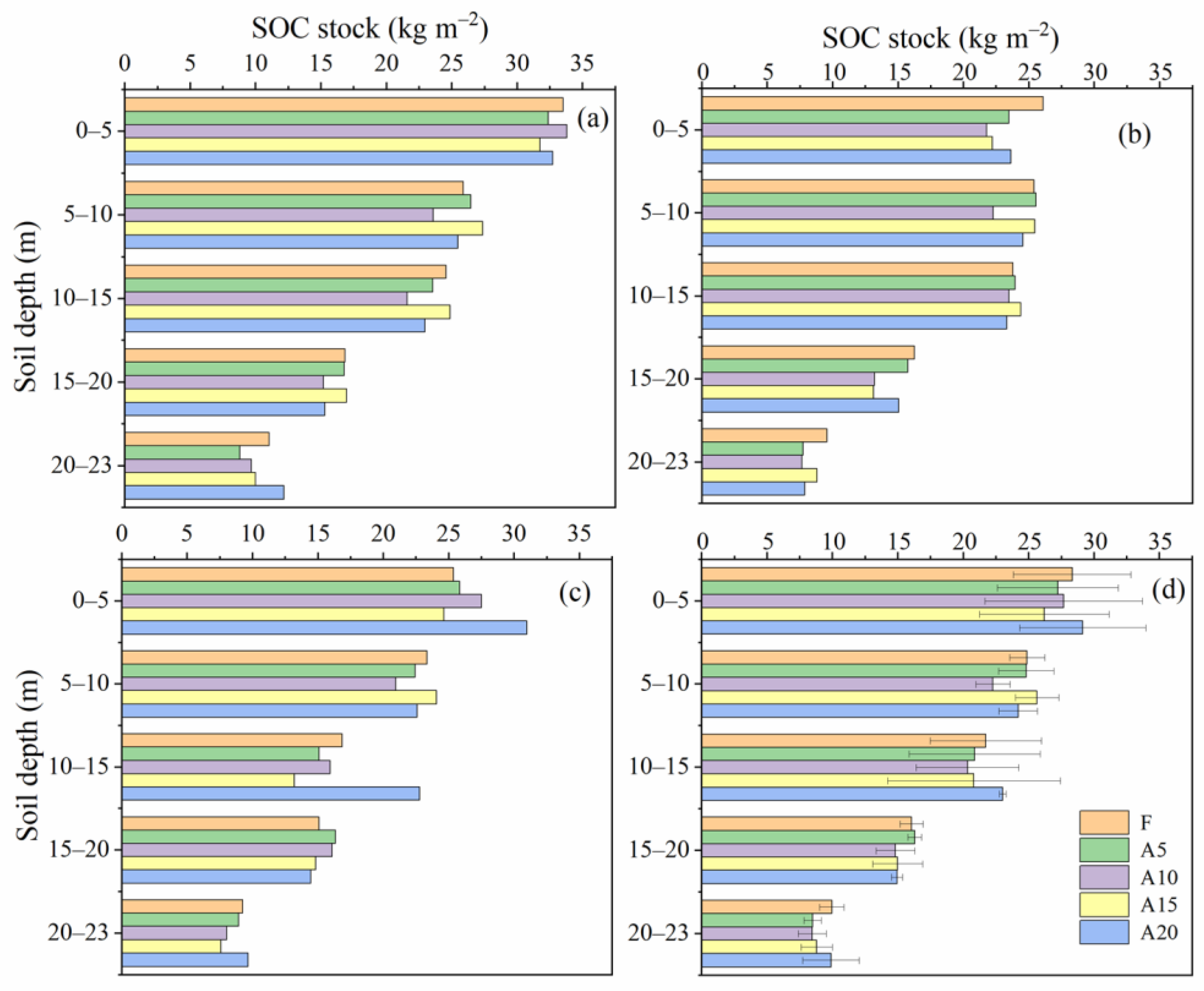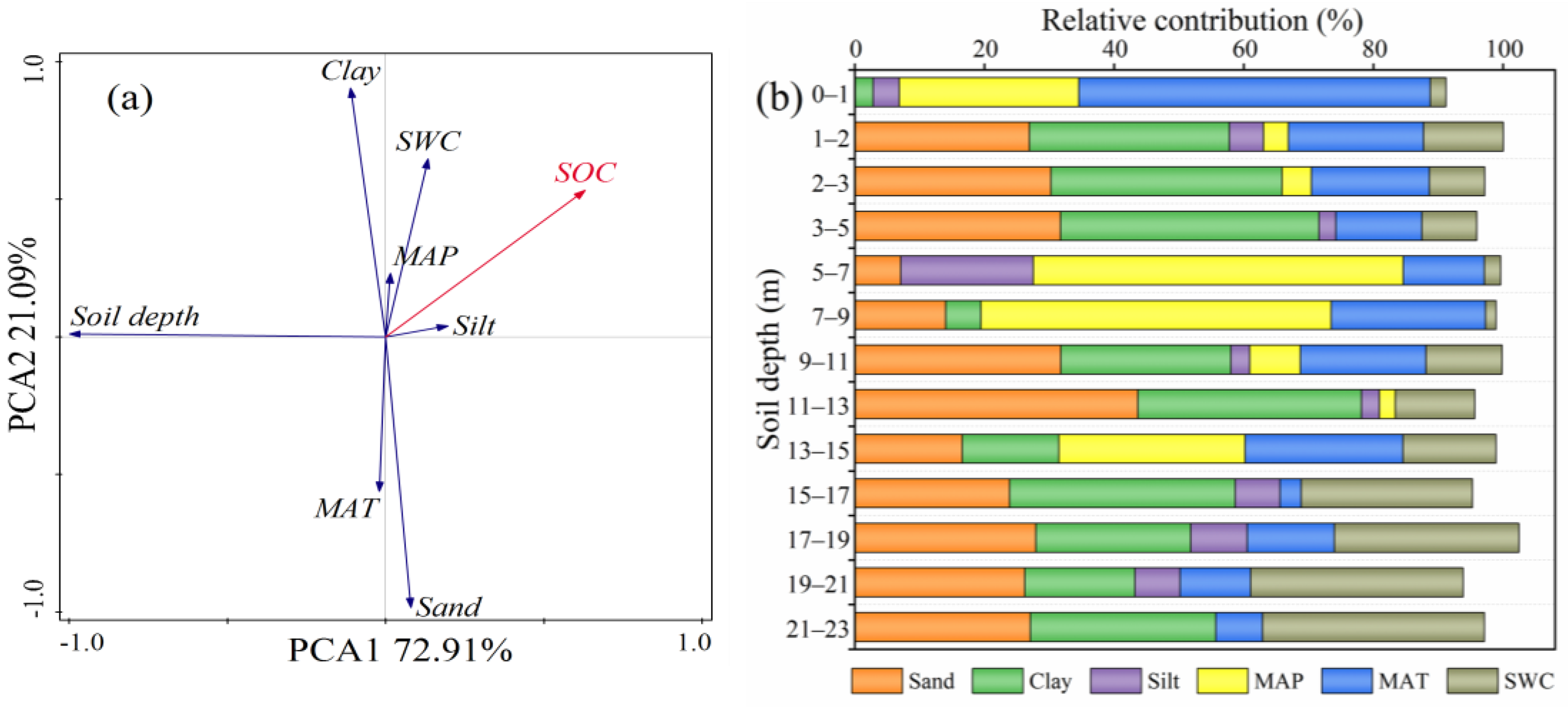Variations in Soil Organic Carbon after Farmland Conversion to Apple Orchard
Abstract
:1. Introduction
2. Materials and Methods
2.1. Study Area
2.2. Soil Sampling and Measurements
2.3. Calculation of SOC Stock
2.4. Statistical Analysis
3. Results
3.1. SOC Variation with Growth Stage and Regions
3.2. Vertical Distribution of SOC along the 0–23 m Profile
3.2.1. SOC in Farmland and Different Growth Stage Orchards
3.2.2. SOC in Different Regions
3.3. Controlling factors of SOC
4. Discussion
4.1. Variations in SOC Affected by Apple Tree Plantation
4.2. Effects of Environmental Factors on SOC
4.3. Implications for Future Economic Forest Management
5. Conclusions
Author Contributions
Funding
Data Availability Statement
Conflicts of Interest
Appendix A

References
- Davidson, E.A.; Trumbore, S.E.; Amundson, R. Soil warming and organic carbon content. Nature 2000, 408, 789–790. [Google Scholar] [CrossRef] [PubMed]
- Post, W.M.; Emanuel, W.R.; Zinke, P.J.; Stangenberger, A.G. Soil carbon pools and world life zones. Nature 1982, 298, 156–159. [Google Scholar] [CrossRef]
- Power, A.G. Ecosystem services and agriculture: Tradeoffs and synergies. Philos. Trans. R. Soc. B Biol. Sci. 2010, 365, 2959–2971. [Google Scholar] [CrossRef]
- Ghimire, R.; Thapa, V.R.; Cano, A.; Acosta-Martinez, V. Soil organic matter and microbial community responses to semiarid croplands and grasslands management. Appl. Soil Ecol. 2019, 141, 30–37. [Google Scholar] [CrossRef]
- Lal, R. Soil carbon sequestration impacts on global climate change and food security. Science 2004, 304, 1623–1627. [Google Scholar] [CrossRef] [PubMed]
- Yang, K.; Wang, K.; Zhang, X.; Chang, X.; Bai, G.; Zheng, J.; Wu, G.L. Change in soil water deficit and soil organic matter consumption over time in rain-fed apricot orchards on the semi-arid Loess Plateau, China. Agric. Ecosyst. Environ. 2021, 314, 107381. [Google Scholar] [CrossRef]
- Hübner, R.; Kühnel, A.; Lu, J.; Dettmann, H.; Wang, W.; Wiesmeier, M. Soil carbon sequestration by agroforestry systems in China: A meta-analysis. Agric. Ecosyst. Environ. 2021, 315, 107437. [Google Scholar] [CrossRef]
- Yang, X.; Li, T.; Shao, M.A. Factors controlling deep-profile soil organic carbon and water storage following Robinia pseudoacacia afforestation of the Loess Plateau in China. For. Ecosyst. 2022, 9, 100079. [Google Scholar] [CrossRef]
- Li, S.; Wei, W.; Liu, S. Long-Term organic amendments combined with nitrogen fertilization regulates soil organic carbon sequestration in calcareous soil. Agronomy 2023, 13, 291. [Google Scholar] [CrossRef]
- Li, B.; Gao, G.; Luo, Y.; Xu, M.; Liu, G.; Fu, B. Carbon stock and sequestration of planted and natural forests along climate gradient in water-limited area: A synthesis in the China’s Loess plateau. Agric. For. Meteorol. 2023, 333, 109419. [Google Scholar] [CrossRef]
- Gao, X.D.; Meng, T.T.; Zhao, X.N. Variations of soil organic carbon following land use change on deep-loess hillsopes in China. Land Degrad. Dev. 2017, 28, 1902–1912. [Google Scholar] [CrossRef]
- Jobbagy, E.G.; Jackson, R.B. The vertical distribution of soil organic carbon and its relation to climate and vegetation. Ecol. Appl. 2000, 10, 423–436. [Google Scholar] [CrossRef]
- Maeght, J.L.; Rewald, B.; Pierret, A. How to study deep roots—And why it matters. Front. Plant Sci. 2013, 4, 299. [Google Scholar] [CrossRef] [PubMed]
- Rumpel, C.; Koegel-Knabner, I. Deep soil organic matter-a key but poorly understood component of terrestrial C cycle. Plant Soil 2011, 338, 143–158. [Google Scholar] [CrossRef]
- Cao, J.B.; He, X.X.; Chen, Y.Q.; Chen, Y.P.; Zhang, Y.J.; Yu, S.; Zhou, L.X.; Liu, Z.F.; Zhang, C.L.; Fu, S.L. Leaf litter contributes more to soil organic carbon than fine roots in two 10-year-old subtropical plantations. Sci. Total Environ. 2020, 704, 135341. [Google Scholar] [CrossRef] [PubMed]
- Sądej, W.; Żołnowski, A.C. Comparison of the effect of various long-term fertilization systems on the content and fractional composition of humic compounds in Lessive soil. Plant Soil Environ. 2019, 65, 172–180. [Google Scholar] [CrossRef]
- Jia, X.X.; Wu, H.M.; Shao, M.; Huang, L.M.; Wei, X.R.; Wang, Y.Q.; Zhu, Y.J. Re-evaluation of organic carbon pool from land surface down to bedrock on China’s Loess Plateau. Agric. Ecosyst. Environ. 2020, 293, 106482. [Google Scholar] [CrossRef]
- Sądej, W.; Żołnowski, A.C.; Marczuk, O. Content of phenolic compounds in soils originating from two long-term fertilization experiments. Arch. Environ. Prot. 2016, 42, 104–113. [Google Scholar] [CrossRef]
- Tao, Z.; Neil, E.; Si, B.C. Determining deep root water uptake patterns with tree age in the Chinese loess area. Agric. Water Manag. 2021, 249, 106810. [Google Scholar] [CrossRef]
- Li, H.J.; Si, B.C.; Ma, X.J.; Wu, P.T. Deep soil water extraction by apple sequesters organic carbon via root biomass rather than altering soil organic carbon content. Sci. Total Environ. 2019, 670, 662–671. [Google Scholar] [CrossRef] [PubMed]
- Yang, F.; Huang, M.; Li, C.; Wu, X.; Guo, T.; Zhu, M. Changes in soil moisture and organic carbon under deep-rooted trees of different stand ages on the Chinese Loess Plateau. Agric. Ecosyst. Environ. 2022, 328, 107855. [Google Scholar] [CrossRef]
- Gan, Z.T.; Zhang, Z.Q.; Chen, J.; Liu, W.Z.; Zhou, Z.C. Spatial deitribution of soil organic carbon in apple orchards on Loess Tableland. Acta Ecol. Sin. 2010, 30, 2135–2140. [Google Scholar]
- Zhang, R.Q.; Huang, Q.Q.; Yan, T.Y.; Yang, J.F.; Zheng, Y.; Li, H.K.; Li, M. Effects of intercropping mulch on the content and composition of soil dissolved organic matter in apple orchard on the loess plateau. J. Environ. Manag. 2019, 250, UNSP109531. [Google Scholar] [CrossRef] [PubMed]
- Shi, Z.L.; Li, X.Y.; Zhang, L.; Wang, Y.Q. Impacts of farmland conversion to apple (Malus domestica) orchard on soil organic carbon stocks and enzyme activities in a semiarid loess region. J. Plant Nutr. Soil Sci. 2015, 178, 440–451. [Google Scholar] [CrossRef]
- Li, R.F.; Wang, Y.P.; Ji, W.J.; Liu, W.Z.; Li, Z. Water deficit limits soil organic carbon sequestration under old apple orchards in the loess-covered region. Agric. Ecosyst. Environ. 2024, 359, 108739. [Google Scholar] [CrossRef]
- Zhu, Y.J.; Jia, X.X.; Shao, M. Loess thickness variations across the Loess Plateau of China. Surv. Geophys. 2018, 39, 715–727. [Google Scholar] [CrossRef]
- Feng, X.M.; Fu, B.J.; Piao, S.; Wang, S.H.; Ciais, P.; Zeng, Z.Z.; Lu, Y.H.; Zeng, Y.; Li, Y.; Jiang, X.H.; et al. Revegetation in China’s Loess Plateau is approaching sustainable water resource limits. Nat. Clim. Chang. 2016, 6, 1019. [Google Scholar] [CrossRef]
- Song, X.; Gao, X.; Zhao, X.; Wu, P.; Dyck, M. Spatial distribution of soil moisture and fine roots in rain-fed apple orchards employing a Rainwater Collection and Infiltration (RWCI) system on the Loess Plateau of China. Agric. Water Manag. 2017, 184, 170–177. [Google Scholar] [CrossRef]
- Bai, Y.X.; Zhou, Y.C. The main factors controlling spatial variability of soil organic carbon in a small karst watershed, Guizhou Province, China. Geoderma 2020, 357, 113938. [Google Scholar] [CrossRef]
- Stumpf, F.; Keller, A.; Schmidt, K.; Mayr, A.; Gubler, S. Spatio-temporal land use dynamics and soil organic carbon in Swiss agroecosystems. Agric. Ecosyst. Environ. 2018, 258, 129–142. [Google Scholar] [CrossRef]
- Li, Q. Land Resources Utilization and Optimal Allocation in the Southern Loess Plateau Based on GIS; Science Press: Beijing, China, 2016. [Google Scholar]
- Nelson, D.W.; Sommers, L.E. Total carbon, organic carbon, and organic matter. Methods of Soil Analysis, Part 2. Chem. Microbiol. Prop. 1982, 9, 539–579. [Google Scholar]
- Wang, Y.Q.; Shao, M.A.; Liu, Z.P.; Zhang, C.C. Prediction of bulk density of soils in the Loess Plateau region of China. Surv. Geophys. 2014, 35, 395–413. [Google Scholar] [CrossRef]
- Song, X.L.; Wu, P.T.; Gao, X.D.; Yao, J.; Zou, Y.F.; Zhao, X.N.; Siddique, K.; Hu, W. Rainwater collection and infiltration (RWCI) systems promote deep soil water and organic carbon restoration in water-limited sloping orchards. Agric. Water Manag. 2020, 242, 106400. [Google Scholar] [CrossRef]
- Xie, M.; Yuan, J.; Liu, S.; Xu, G.; Lu, Y.; Yan, L.; Li, G. Soil carbon and nitrogen pools and their storage characteristics under different vegetation restoration types on the Loess Plateau of Longzhong, China. Forests 2024, 15, 173. [Google Scholar] [CrossRef]
- Xu, H.; Qu, Q.; Wang, M.; Li, P.; Li, Y.; Xue, S.; Liu, G. Soil organic carbon sequestration and its stability after vegetation restoration in the Loess Hilly Region, China. Land Degrad. Dev. 2020, 31, 568–580. [Google Scholar] [CrossRef]
- Liu, C.; Jia, X.; Ren, L.; Zhao, C.; Yao, Y.; Zhang, Y. Cropland-to-shrubland conversion reduces soil water storage and contributes little to soil carbon sequestration in a dryland area. Agric. Ecosyst. Environ. 2023, 354, 108572. [Google Scholar] [CrossRef]
- Deng, L.; Liu, G.B.; Shangguan, Z.P. Land-use conversion and changing soil carbon stocks in China’s ‘Grain-for-Green’ Program: A synthesis. Glob. Chang. Biol. 2014, 20, 3544–3556. [Google Scholar] [CrossRef] [PubMed]
- Jiang, R.; Gunina, A.; Qu, D.; Kuzyakov, Y.; Li, M. Afforestation of loess soils: Old and new organic carbon in aggregates and density fractions. Catena 2019, 177, 49–56. [Google Scholar] [CrossRef]
- Brunner, I.; Herzog, C.; Dawes, M.A.; Arend, M.; Sperisen, C. How tree roots respond to drought. Front. Plant Sci. 2015, 6, 152207. [Google Scholar] [CrossRef]
- Jia, J.; Cao, Z.; Liu, C.; Zhang, Z.; Lin, L.; Wang, Y.; Haghipour, N.; Wacker, L.; Bao, H.; Dittmar, T.; et al. Climate warming alters subsoil but not topsoil carbon dynamics in alpine grassland. Glob. Chang. Biol. 2019, 25, 4383–4393. [Google Scholar] [CrossRef] [PubMed]
- Davidson, E.; Lefebvre, P.A.; Brando, P.M.; Ray, D.M.; Trumbore, S.E.; Solorzano, L.A.; Ferreira, J.N.; Bustamante, M.; Nepstad, D.C. Carbon inputs and water uptake in deep soils of an Eastern Amazon Forest. For. Sci. 2011, 57, 51–58. [Google Scholar] [CrossRef]
- Liu, H.; Liu, J.; Zhang, Z.; Liu, W.; Zhang, Q.; Wang, X.; Ren, C.; Yang, G.; Han, X. The impact of combining Robinia pseudoacacia leaves and corn straw on soil carbon content and corn yield in Loess Plateau. Agronomy 2024, 14, 689. [Google Scholar] [CrossRef]
- Mathieu, J.A.; Hatte, C.; Balesdent, J.; Parent, E. Deep soil carbon dynamics are driven more by soil type than by climate: A worldwide meta-analysis of radiocarbon profiles. Glob. Chang. Biol. 2015, 21, 4278–4292. [Google Scholar] [CrossRef] [PubMed]
- Wang, S.; Wang, X.; Ouyang, Z. Effects of land use, climate, topography and soil properties on regional soil organic carbon and total nitrogen in the Upstream Watershed of Miyun Reservoir, North China. J. Environ. Sci. 2012, 24, 387–395. [Google Scholar] [CrossRef] [PubMed]
- Balesdent, J.; Basile-Doelsch, I.; Chadoeuf, J.; Cornu, S.; Derrien, D.; Fekiacova, Z.; Hatte, C. Atmosphere-soil carbon transfer as a function of soil depth. Nature 2018, 559, 599–602. [Google Scholar] [CrossRef] [PubMed]
- Deng, L.; Wang, K.B.; Zhu, G.Y.; Liu, Y.L.; Chen, L.; Shangguan, Z.P. Changes of soil carbon in five land use stages following 10 years of vegetation succession on the Loess Plateau, China. Catena 2018, 171, 185–192. [Google Scholar] [CrossRef]
- Jia, X.X.; Yang, Y.; Zhang, C.C.; Shao, M.A.; Huang, L.M. A state-space analysis of soil organic carbon in China’s Loess Plateau. Land Degrad. Dev. 2017, 28, 983–993. [Google Scholar] [CrossRef]
- Yu, H.Y.; Zha, T.G.; Zhang, X.X.; Ma, L.M. Vertical distribution and influencing factors of soil organic carbon in the Loess Plateau, China. Sci. Total Environ. 2019, 693, 133632. [Google Scholar] [CrossRef] [PubMed]
- Burke, I.C.; Yonker, C.M.; Parton, W.J.; Cole, C.V.; Flach, K.; Schimel, D. Texture, climate, and cultivation effects on soil organic matter content in U.S. grassland soils. Soil Sci. Soc. Am. J. 1989, 53, 800–805. [Google Scholar] [CrossRef]
- Gao, X.D.; Wu, P.T.; Zhao, X.N.; Shi, Y.G.; Wang, J.W.; Zhang, B.Q. Soil moisture variability along transects over a well-developed gully in the Loess Plateau, China. Catena 2011, 87, 357–367. [Google Scholar] [CrossRef]
- La Manna, L.; Tarabini, M.; Gomez, F.; Rostagno, C.M. Changes in soil organic matter associated with afforestation affect erosion processes: The case of erodible volcanic soils from Patagonia. Geoderma 2021, 403, 115265. [Google Scholar] [CrossRef]
- Gao, X.D.; Liu, Z.P.; Zhao, X.N.; Ling, Q.; Huo, G.P.; Wu, P.T. Extreme natural drought enhances interspecific facilitation in semiarid agroforestry systems. Agric. Ecosyst. Environ. 2018, 265, 444–453. [Google Scholar] [CrossRef]







| Study Region | MAT (°C) | MAP (mm) | Sampling Site (Stand Age) | Height (m) | DBH (cm) | Canopy Diameter (m) |
|---|---|---|---|---|---|---|
| Qingyang | 9.4 | 538 | Farmland (F) | – | – | – |
| A5 (5) | 2.92 ± 0.27 | 11.00 ± 1.13c | 3.79 ± 0.52b | |||
| A10 (12) | 2.56 ± 0.32 | 17.73 ± 2.63b | 4.08 ± 0.60b | |||
| A15 (18) | 2.69 ± 0.47 | 21.30 ± 3.28a | 4.72 ± 0.44a | |||
| A20 (32) | 2.86 ± 0.54 | 20.35 ± 3.47a | 3.87 ± 0.38b | |||
| Changwu | 9.1 | 583 | Farmland (F) | – | – | – |
| A5 (5) | 2.60 ± 0.23 | 6.17 ± 1.04c | 2.02 ± 0.36c | |||
| A10 (10) | 2.73 ± 0.51 | 10.50 ± 1.32b | 2.43 ± 0.24c | |||
| A15 (15) | 3.07 ± 0.23 | 20.56 ± 1.15a | 3.19 ± 0.16b | |||
| A20 (24) | 3.16 ± 0.16 | 22.83 ± 0.76a | 4.36 ± 0.23a | |||
| Luochuan | 9.2 | 608 | Farmland (F) | – | – | – |
| A5 (5) | 3.45 ± 0.46a | 6.96 ± 1.40d | 2.82 ± 0.67c | |||
| A10 (10) | 3.05 ± 0.20b | 12.75 ± 1.30c | 3.81 ± 0.58b | |||
| A15 (15) | 2.95 ± 0.23bc | 15.90 ± 2.163b | 3.87 ± 0.39ab | |||
| A20 (25) | 2.67 ± 0.32c | 20.36 ± 1.85a | 4.34 ± 0.60a |
Disclaimer/Publisher’s Note: The statements, opinions and data contained in all publications are solely those of the individual author(s) and contributor(s) and not of MDPI and/or the editor(s). MDPI and/or the editor(s) disclaim responsibility for any injury to people or property resulting from any ideas, methods, instructions or products referred to in the content. |
© 2024 by the authors. Licensee MDPI, Basel, Switzerland. This article is an open access article distributed under the terms and conditions of the Creative Commons Attribution (CC BY) license (https://creativecommons.org/licenses/by/4.0/).
Share and Cite
Wang, Y.; Li, R.; Yan, W.; Han, X.; Liu, W.; Li, Z. Variations in Soil Organic Carbon after Farmland Conversion to Apple Orchard. Agronomy 2024, 14, 963. https://doi.org/10.3390/agronomy14050963
Wang Y, Li R, Yan W, Han X, Liu W, Li Z. Variations in Soil Organic Carbon after Farmland Conversion to Apple Orchard. Agronomy. 2024; 14(5):963. https://doi.org/10.3390/agronomy14050963
Chicago/Turabian StyleWang, Yaping, Ruifeng Li, Weiming Yan, Xiaoyang Han, Wenzhao Liu, and Zhi Li. 2024. "Variations in Soil Organic Carbon after Farmland Conversion to Apple Orchard" Agronomy 14, no. 5: 963. https://doi.org/10.3390/agronomy14050963
APA StyleWang, Y., Li, R., Yan, W., Han, X., Liu, W., & Li, Z. (2024). Variations in Soil Organic Carbon after Farmland Conversion to Apple Orchard. Agronomy, 14(5), 963. https://doi.org/10.3390/agronomy14050963






